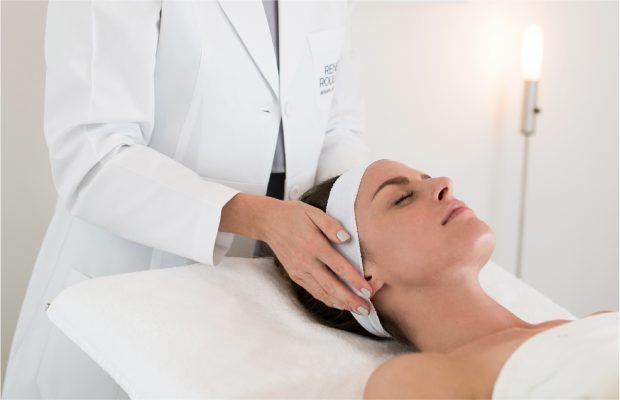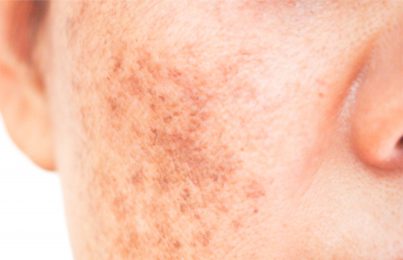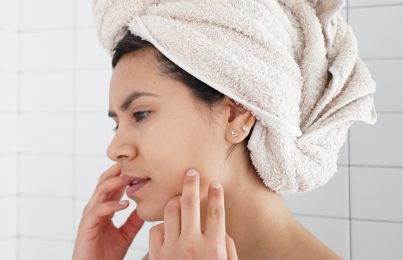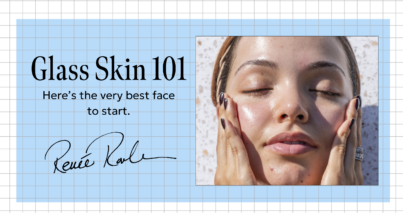Updated 09/01/22. Over the course of my career as an esthetician, I’ve performed countless chemical peels. I’ve seen with my own eyes how they can create positive change in the skin and improve the appearance of fine lines and wrinkles, hyperpigmentation, post-breakout marks, and enlarged pores. There’s truly nothing else that does what a chemical peel can do!
What you should know is that not all chemical peels are the same. There are many different types and strengths. While it’s important to consult an experienced skin expert, such as an esthetician or dermatologist, to find out which one is best for you and your specific skin concerns, I thought I’d share some insight from my 30+ years of experience. Keep scrolling to find out what type of chemical peel is best for you, according to your skin type.
What Is a Chemical Peel?
A chemical peel is a skin treatment that involves applying acids and/or enzymes to the face to lower the pH of the skin. This puts the skin in an acidic state to dissolve and digest dead skin cells. Depending on the strength of the peel, this may result in some flakiness or peeling (hence the name) as the old skin cells shed. Eventually, the shedding will stop and newer, fresher-looking skin will be revealed. Basically, it’s a way to speed up cell turnover to resurface the skin.
What’s the Process Like?
If it’s a light chemical peel, it can be performed during a facial. Typically, the esthetician will cleanse the skin and apply the peel before any other products. This will remove dead, dry skin cells right from the start, so the products that are applied after can penetrate deeper and work more effectively.
If it’s a stronger chemical peel, it usually won’t be performed as part of a facial. Instead, it’ll be performed on its own as a separate treatment. Typically, the esthetician or dermatologist will start by cleansing the skin and prepping it with what’s called a “degreaser.” This is usually an alcohol-based solution that cuts oil from the skin. It dries out the skin and can even disrupt the moisture barrier, but it’s the best way to remove oil so the peel can work effectively. Once that’s applied, they will apply the peeling solution, wait anywhere from 3-10 minutes, and remove it with a lukewarm towel or gentle facial sponges.
Depending on the peel, they might then use a neutralizer to make sure the peel stops working. Remember how I said a chemical peel works by lowering the pH of the skin? Well, a neutralizer is a solution that brings the skin’s pH back up to its normal level, which is around 5.5. It ensures the peeling action will stop, and it’s usually the very last step in the process.
Who Can Benefit from a Chemical Peel?
Trust me when I say that chemical peels can benefit ALL skin types. As I said before, peels can improve the appearance of everything from acne and enlarged pores to brown spots and melasma. The fact is that no matter what your skin concerns are, a chemical peel can create positive, visible change when performed properly under the direction of an experienced skin expert.
How Often Should I Get a Chemical Peel?
Again, this will depend on your unique skin concerns and goals. Generally speaking, though, they are often repeated every one to six weeks to achieve the desired results. Many people will get them prior to a special event, like a wedding or class reunion, since they can provide visible results fairly quickly.
It’s worth noting that people who have sensitive skin, use a prescription retinoid, or have a compromised barrier, won’t need to get chemical peels as regularly as others. They’re also going to require gentler peels. Typically, stronger peels contain higher percentages of acids, and they can be too harsh on sensitive skin. Again, an experienced skin expert will be able to tell you the exact peel that’s best for you.
What Chemical Peel Should I Get?
No surprise here—the type of chemical peel you should get fully depends on your skin type. If you’re a regular reader of my blog, you know I believe there are 9 Skin Types—and each one has distinct needs and characteristics. If you don’t know your skin type, take this quick Skin Type Quiz to find out. Not only will you learn your skin type, but you’ll also get personalized product recommendations.
Ahead, see the chemical peels I recommend for each skin type.
Skin Type 1
The characteristics of Skin Type 1 include extremely oily skin, large pores, constant and severe breakouts, and stubborn post-breakout marks. As such, the chemical peel that would best benefit someone with this skin type is a salicylic acid peel. That’s because salicylic acid is oil-soluble, meaning it can penetrate through oil and into the pore lining to clear blockages and prevent breakouts from forming.
Skin Type 2
People with Skin Type 2 often experience enlarged pores, blackheads, occasional and mild breakouts, and tight and/or irritated skin. For this type of skin, I recommend a peel that has a combination of salicylic, lactic, and glycolic acids. Salicylic acid, which is oil-soluble, will penetrate the pore lining and address clogged pores and breakouts, while lactic and glycolic acids, which are water-soluble, will work on the surface to dissolve and digest dead skin cells.
Skin Type 3
Just like Skin Type 1, the best chemical peel for someone with Skin Type 3 is a salicylic acid peel. That’s because breakouts are a major concern for this skin type. Characteristics include enlarged pores, consistent breakouts, redness, tightness, and irritation.
Skin Type 4
Skin Type 4 is considered to be a combination skin type. It’s characterized by enlarged pores and excessive oil production in the t-zone, skin that becomes red and flushed easily, and post-breakout marks that linger for weeks and months. For this skin type, I recommend a peel that has a combination of salicylic, lactic, and glycolic acids.
Again, the salicylic acid will penetrate the pore lining and address clogged pores and breakouts, while the lactic and glycolic acids will work on the surface to dissolve and digest dead skin cells. Of course, the specific percentages of each acid in the peel will have to be decided by your skin professional.
Skin Type 5
People with Skin Type 5 experience a lot of redness and sensitivity, which is why I recommend avoiding harsh chemical peels. Instead, go for a lactic acid peel. Lactic acid is gentle on the skin; it doesn’t have the same irritation potential as other acids.
Skin Type 6
Skin Type 6 is considered normal. This skin type produces oil in the summer and mostly in the t-zone. It can feel dry or tight during the winter. People with this skin type may be concerned with dullness and hyperpigmentation. Mainly, they’re concerned about aging and loss of tone.
When it comes time for a chemical peel, I suggest getting one that has a blend of the following acids: Malic, tartaric, lactic, glycolic, and/or mandelic acids. Since Skin Type 6 isn’t necessarily sensitive, it can typically handle a variety of acids in a variety of percentages to reap all the benefits.
Skin Type 7
Oftentimes, people with Skin Type 7 are mainly focused on addressing signs of aging like dullness and hyperpigmentation. That’s why I suggest using the same combination peel I recommend for Skin Type 6, but this time, applying a leave-on retinol product once the peel has been removed. This accelerates the peeling process, as the retinol can penetrate deeply and encourage more intensive resurfacing, which is often necessary for this skin type.
Skin Type 8
The same goes for Skin Type 8. Since sun damage and hyperpigmentation are the main concerns with this skin type, a more intensive peel can be beneficial for lifting and removing discoloration. Trust me, applying a retinol product post-peel can make a big difference!
Skin Type 9
People with Skin Type 9 may experience consistent dryness along with redness and rosacea. Since their skin tends to act sensitive, I recommend staying away from strong peels that contain a blend of acids. Instead, I suggest a gentle lactic acid peel.
What Can I Expect After a Chemical Peel?
The amount of peeling you’ll experience and the length of downtime you can expect all depend on the percentage of acids that were used and the length of time they were left on the skin. Even at its worst, visible peeling can be minimized by gently applying a face oil or moisturizer to the skin. (Personally, I love using the Pro Remedy Oil and the Phytolipid Comfort Creme). Most people find it to be manageable and oftentimes, the peeling won’t last for more than a few days.
Of course, you certainly wouldn’t want to get a peel too soon before a special event. You should schedule it in advance so your skin has time to naturally shed and resurface. I always advise people get a peel on a Wednesday. That way, most of the dryness, flakiness, and peeling will occur on the weekend. If you want it to occur during the week, get the peel on a Friday or Saturday.
Immediately After a Chemical Peel
You can expect your skin to look pink and flushed. It will likely be warm to the touch and have a tight and shiny look to it.
Within the First 2 Days After a Peel
During the first two days after a peel, you can expect your skin to look only slightly pink. It will start to feel tighter.
Within 3-6 Days After a Peel
During the first four to six days, you can expect your skin to become dry and begin flaking and peeling. This is normal! Don’t try to remove or minimize the flaking and peeling. These dead cells could very well be attached to live cells, and removing them could cause injury to the skin and result in bleeding and oozing (not good!). It’s best to leave it alone and let your skin shed naturally.
How Should I Care for My Skin After a Chemical Peel?
Proper aftercare is so important when it comes to chemical peels. At the time of your appointment, the esthetician or dermatologist should have provided you with specific instructions, so be sure to follow those. With that said, there are a few general guidelines to follow. You should wear sunscreen since your skin will be extremely vulnerable. You should also be extra gentle with it and avoid rubbing it or touching it.
For detailed instructions, read how to properly care for your skin after a chemical peel.
How Can I Extend the Results of a Chemical Peel?
A consistent skincare routine is the key to maintaining the results of a chemical peel. At the very least, that means cleansing your skin both morning and night, applying a targeted treatment serum, and moisturizer. Make sure you’re using a moisturizer with SPF during the day. After all, sunscreen is the number one most important daily skincare product!
I also suggest using exfoliating acids in your at-home skincare routine. I always say a chemical peel is like breaking through the concrete—that is, it’s dissolving and digesting dead and discolored cells. To maintain results and ensure other products are able to continue penetrating deeply and working effectively, I suggest incorporating an exfoliating acid serum or mask into your routine.
While there are many products in my line that contain exfoliating acids, I always suggest using the Pro Results Power Serum if your main concerns are sun damage and hyperpigmentation. It uses glycolic, lactic, and mandelic acids to target stubborn brown spots and other signs of sun damage. Over time, it can lead to a brighter, smoother complexion.
Next, check out five ways Botox can improve your appearance (and quality of life)!
Celebrity Esthetician & Skincare Expert
As an esthetician trained in cosmetic chemistry, Renée Rouleau has spent 35 years researching skin, educating her audience, and building an award-winning line of products. Her hands-on experience as an esthetician and trusted skin care expert has created a real-world solution — products that are formulated for nine different types of skin so your face will get exactly what it needs to look and feel its best. Trusted by celebrities, editors, bloggers, and skincare obsessives around the globe, her vast real-world knowledge and constant research are why Marie Claire calls her “the most passionate skin practitioner we know.”




Comments:
This is a useful article. Chemical peel really helps me with my skin problems.
Posted By: AesthetHouse |
I just read your article on “The Best Chemical Peel for You, According to Your Skin Type” and I must say it’s impressive. Your comprehensive guide on the different types of chemical peels and how they work on different skin types is informative and helpful. Your attention to detail is remarkable and it shows that you put in a lot of effort to research and compile this guide. Thank you for sharing this valuable information with everyone! Kudos to you.
Posted By: Dr.Tina's Skin Solutionz |
Such a nice and informative post!
Posted By: Urist Cosmetics Inc |